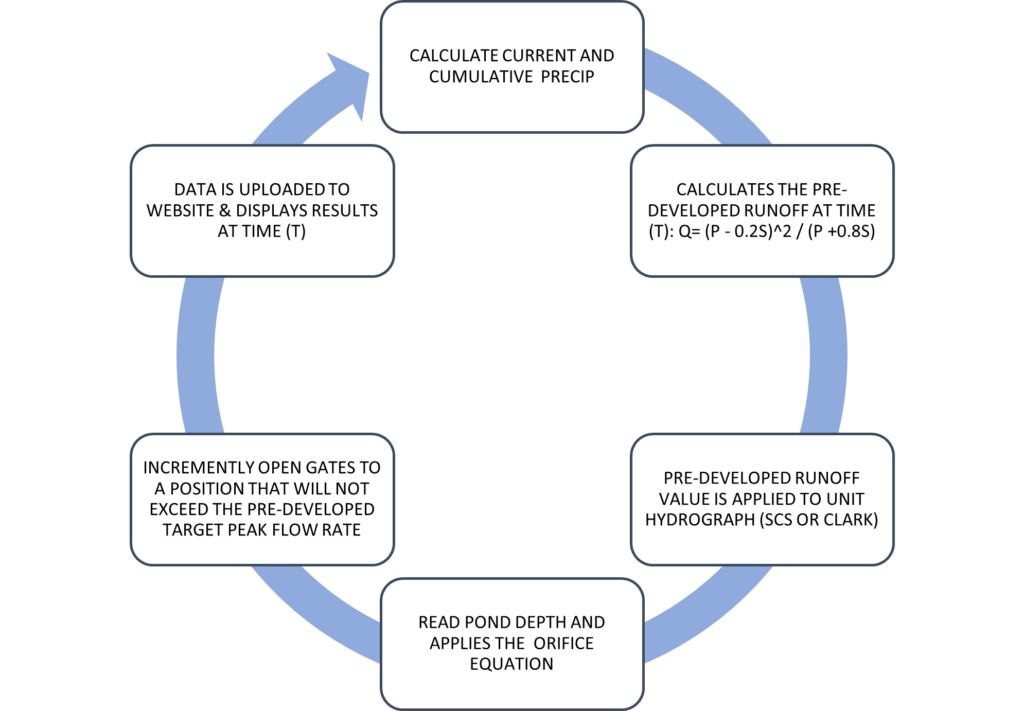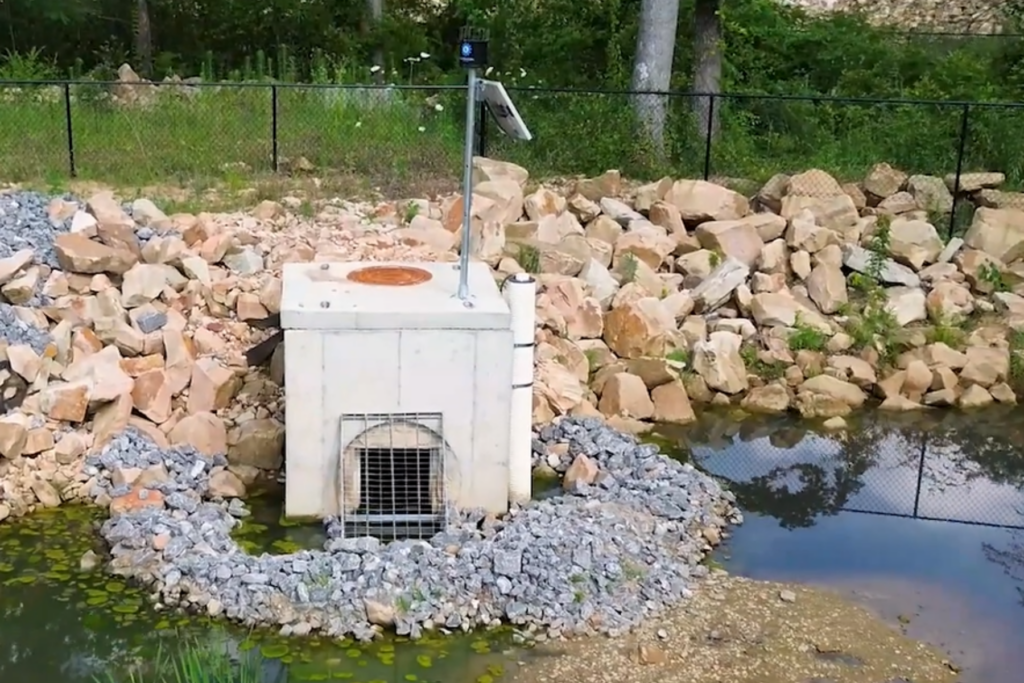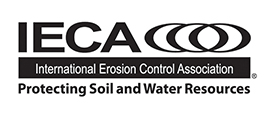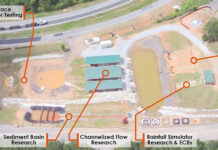
Stormwater detention systems gained prominence in the mid to late 20th century as environmental awareness grew. In the United States, The Clean Water Act of 1972 played a pivotal role in regulating water pollution and promoting stormwater management practices. Since then, stormwater detention has become a standard component in urban and suburban stormwater management plans to mitigate runoff impacts.
Storage and treatment systems, including detention and retention ponds, typically have a lifespan of 20 to 30 years. Systems constructed before the 1990s are now reaching the end of their useful lives and are often undersized considering current stormwater management practices and climate change impacts. The trajectory of urban flooding impacts is expected to rise due to the inability of older stormwater assets to accommodate changing rainfall patterns and intensity. Challenges such as downstream erosion, sedimentation and delays in peak flows have accumulated over time, contributing to significant changes in the watershed’s natural hydrologic conditions.
Even with stormwater regulations in place, the growth of some areas since the 1970s affects the effectiveness of practices used to control flooding. Patton Creek in Jefferson County, Alabama, will overtop its banks in urban areas, and flood a state highway and businesses following a 3.5-inch (89-mm) rain. The characteristics of the creek basin changed over time from a rural to high urban footprint. Even with stringent stormwater regulations, the creek is still a prominent flood source. Conventional methods to fix the flooding require costly, invasive modifications to the stream to increase its capacity and severely restricts new development.

Outlet Control Options
One of the less invasive methods used to manage stormwater flow and reduce the risk of flooding is the use of conventional outlet control structures (OCS). They are designed to regulate stormwater flow from a detention basin or pond to prevent downstream flooding and erosion. However, conventional OCSs have limitations, including delayed peak time, inflexibility to high-intensity storms, high clogging potential and increased pond volume requirements.
Conventional OCSs are calibrated to a design storm, a synthetic event that does not account for multiple peak intensities or changes in antecedent moisture conditions. This limitation, coupled with the dependence on depth for release rate adjustments, poses challenges in adapting to high-intensity cloud burst events from today’s storm patterns.
For situations like Patton Creek in Alabama, an Automated Outlet Structure (AOS) provides a non-invasive approach to correcting the problem because the systems are installed offline of the creek by retrofitting in existing ponds and lakes — attacking the problem at its source. This method restores not only the creek, but also the existing streams that flow into the creek, which is good for environmental habitats, pedestrians, homeowners and businesses throughout the watershed.
Flood-Con’s AOS is an intelligent device that replaces the traditional outlet structure. It can be described as a robot dam that is comprised of a rain gauge, depth sensor, mechanically controlled gates and an onboard microcontroller. The microcontroller is the brain that takes readings from the rain gauge and depth sensor and uses those readings to open the gate to a specific width to control the release of water from the pond.
The microcontroller has programming that uses hydrologic factors specific to the pond and the watershed. Using this intelligence, the outlet structure requires anywhere from 30% to 50% less volume of pond to meet regulatory requirements. For aboveground ponds, this results in less disturbed land and more property to develop, which creates more value for the developer. In a Hoover, Alabama, residential subdivision, the Automated Outlet Structure reduced the depth of mass rock excavation by up to 4 feet (1.2 m), resulting in shallower stormwater ponds.
For underground ponds, an AOS provides significant savings to the developer in materials and construction cost. An AOS at Bellmont University in Nashville, Tennessee, contributed to a 35% reduction in the volume of underground detention and minimized the footprint of the underground pond, enabling the pond to seamlessly integrate with the site’s limitations.
An AOS incorporates one or more gates that incrementally open and close, allowing horizontal or vertical control of stormwater flow from the detention pond. Unlike traditional structures, the AOS is at one invert elevation to optimize the pond’s full volume. The device is normally installed in reservoirs or water bodies such as a stormwater pond or lake. It also can be easily retrofitted in existing water bodies to prevent pond expansion.
A solar panel powers the automated system, ensuring continuous operation with a 12-volt battery that provides up to 30 days of backup power if the solar panel fails. During a rain event, the onboard microcontroller calculates predevelopment flow and required gate open area at set intervals based on rain and pond depth readings.
The system uses 5G-LTE cellular communication to transmit vital device health information during rain events to report key metrics. Even without cellular connectivity, the outlet structure continues normal operation. Each system incorporates site-specific data to calculate reduced pond staged storage and determine the required AOS maximum open area to meet municipal stormwater management requirements (Figure 1). Additional sensor setups include turbidity, total suspended solids, oil, dissolved oxygen, conductivity, Mono Ethylene Glycol and Mono Propylene Glycol and pH.
Beyond detention, every system can provide forecast-based release for retention (wet) ponds to offer flood mitigation and emergency management capabilities. Redevelopment of the existing Barlow Dam, located in Hudson, Ohio, included modifications aimed at increasing regional flooding storage capacity by an additional 9.5 acre-feet (11,718 m3). The project included upgrading active controls, enhancing flood stormwater storage and incorporating an aesthetically pleasing design. The device installed in the Barlow Dam also has the capability to remotely provide a pre-event release to provide additional storage capacity for flood mitigation (Figure 2).
Similar to conventional outlet control structures, each AOS is tailored to the unique characteristics of the watershed it serves, ensuring optimal performance in managing runoff. The versatility of AOS extends across a spectrum of watershed sizes and flow rates, accommodating areas ranging from half-acre (0.2-ha) plots to expansive one-square-mile (2.59 km2) regions. Specialized AOS units are capable of effectively regulating peak flows of up to 700 feet3 per second (20 m3 per second).
Given the variability of stormwater regulations across different jurisdictions, an annual maintenance and monitoring agreement ensures compliance by providing notifications and complimentary access to a website console for the engineer of record, property owner and regulatory authority. Biannual inspections conducted by Flood-Con authorized representatives include detailed reports and photos that are uploaded to the website console to fulfill local post-construction stormwater BMP inspection requirements, where applicable.
The key benefits of an AOS include:
- Typically provides 35% less storage volume than a traditional outlet structure, which requires less land for detention, achieving an average savings of $45,000 per developed acre.
- Adjusts to actual rainfall in real-time, continues to attenuate flow after the peak of the event and manages the timing of the peak flow to prevent downstream basin peak flow contributions.
- Applies a recession algorithm to prevent extended high flows that typically occur with conventional OCSs.
- Performs daily diagnostic routines and hourly sensor monitoring every day and provides time-stamped data at intervals as often as one minute. Notifications of noncompliant conditions are sent to authorized representatives, and proof of compliance for every rain event is provided with real-time data to a computer or smartphone.
- Prevents clogging with a self-flushing adjustable weir.
- Serves as a tide gate for backwater prevention during high tides and withstands tailwater and submerged conditions.
- Maximizes infiltration volume for green infrastructure practices and stores runoff for water reuse.
- Updates remotely to allow for watershed calibration.
- Installs inside a concrete box that meets local agency specifications.
All logic is entirely housed on the AOS. The AOS sends health data every three hours when not in a storm event. This health data generates SMS and email alerts to authorized representatives if vital signs fall below specified thresholds. The alerts are sent directly from the device or through cloud-based application programming interfaces and a browser-based flow editor, incorporating onboard maintenance routines for gate functionality. Any issues can be remotely troubleshooted through commands sent to the device. Aboveground components are typically limited to a rain gauge and solar panel (Figure 3).

Conclusion
The standard practice for stormwater detention is outdated and needs to be revolutionized. Automated controlled release is an example of the benefits of incorporating new technology into stormwater management practices. For example, on a 5-acre (2-ha) commercial development, Flood-Con’s
AOS halved the volume of underground detention, saving nearly $200,000 in construction cost. Given the availability and cost-effectiveness of this technology, a paradigm shift in stormwater management is essential to combat flooding from a local and regional perspective.
About the Expert
Jon E. Rasmussen, PE, CPESC, LEED AP BD+C is president and CEO of Flood-Con LLC, an automated stormwater management company that provides cutting edge technology through its patented products and engineering services.











